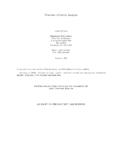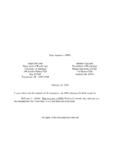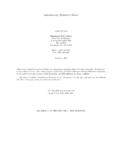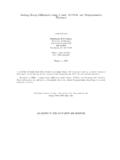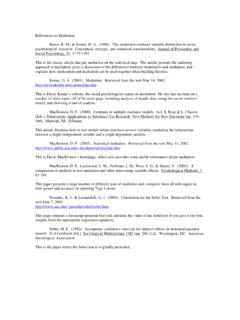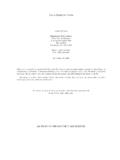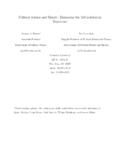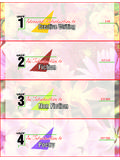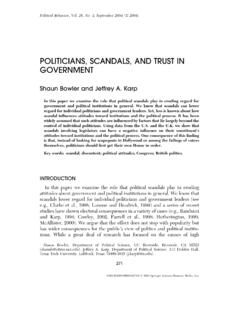Transcription of Scale Construction Notes - Stat-Help.com
1 Scale Construction NotesJamie DeCosterDepartment of PsychologyUniversity of Alabama348 Gordon Palmer HallBox 870348 Tuscaloosa, AL 35487-0348 Phone: (205) 348-4431 Fax: (205) 348-8648 June 5, 2000 These Notes were prepared with the support of a grant from the Dutch Science Foundation to G un Semin. Iwould like to thank Heather Claypool and Dick Heslin for comments made on earlier versions of these you wish to cite the contents of this document, the APA reference for them would beDeCoster, J. (2005). Scale Construction <month, day, and year you downloaded thisfile>from future versions of these Notes or help with data analysis RIGHTS TO THIS DOCUMENT ARE Introduction12 Creating Items23 Data Collection and Entry54 Validity and Reliability75 Measuring More than One Variable with a Scale136 The Role of Revision157 Reporting a Scale17iChapter 1 Introduction The purpose of Scale Construction is to design a questionnaire that provides a quantitative measurementof an abstract theoretical variable.
2 Scale Construction can be seen as a specialized area of survey design. Not all surveys are scales, trying to apply the procedures presented here to the Construction of your questionnaire youshould decide whether it really is a most obvious key is that a Scale uses a moderately large number of items to measure a singleconstruct. The items within a Scale are typicallyinterchangeable, meaning that the response to oneitem has exactly the same theoretical meaning as the response to any other item within the Scale . Eachitem is designed to be a different way to ask about the same theoretical variable. Some questionsmay written so that more positive responses indicate less of the variable in question (see the note onreverse coding in section ), but the expectation is that the magnitude of the correlations betweenitems (whether positive or negative) should be relatively high throughout a , after a participant completes a Scale the responses are aggregated in some way, such asby taking the average, to produce the actual measurement.
3 The specific response provided to anyindividual question is usually not of interest. good scales possess bothvalidityandreliability. A Scale has validity if it properly represents thetheoretical construct it is meant to measure. A Scale has reliability if repeated measurements underthe same circumstances tend to produce the same results. These two concepts are very important toscale Construction and will be discussed in greater detail in chapter 4. Sometimes a single questionnaire contains items from several different scales mixed together. This isperfectly legitimate. In this case your items will not all be interchangeable - items making up differentsubscales will be slightly different. The items should, however, be interchangeable within each information on working with these types of scales is provided in chapter 2 Creating ItemsThis chapter provides a set of guidelines for writing good Scale items.
4 These guidelines are designed toproduce scales possessing high validity and reliability (discussed in chapter 4). While the chapter doespresent some specific do s and don ts, it is much better to keep the general principles in mind whilewriting questions than to simply obey the specific rules. writing good scales is definitely an art rather thana science. Each section below introduces a basic guideline to be followed when writing items, provides ajustification for it, and lists a few specific ways it can be Make the questions simple You want to make your items as simple and straightforward as possible so that your respondents areable to fill out the Scale quickly and easily. Complicated scales can lead to misunderstandings and annoyrespondents, reducing the likelihood that you obtain good data using the Scale . Other researchers willalso be more likely to use your Scale if it can be completed in a short period of time.
5 You should design your items so that they can be answered with very little instruction. The responseformat should be obvious even to someone who has not read your introductory paragraph. This isnecessary because you will have a certain percentage of your respondents who will fail to read yourinstructions. Always avoiddouble-barreled questions, where the item actually combines two different questions intoone. Consider the item Do you think that the technical service department is prompt and helpful? While some respondents may be able to quickly put down an opinion (if they universally like or dislikethe technical service department), those who think that the service is prompt but unhelpful or thereverse would have difficulty answering the question. Any item that includes the word and shouldbe closely examined to see if it is actually a double-barreled question.
6 You should also avoidnonmonotonic questions, where people could provide the same answer to aquestion for two different reasons. Consider the item Only people in the military should be allowedto personally own assault rifles. Someone could disagree with this statement either because they feelthat non-military people should be allowed to own assault rifles or because they feel that no one shouldbe allowed to own assault Make the questions clear Unclear questions can cause respondents to interpret your items in different ways, reducing the likeli-hood that they will answer in ways that are related to the theoretical construct of interest. An itemshould be designed such that every respondent interprets it in the same way. You should avoid using any vague words or phrases in your items. Consider the question How doyou feel about the organization you work for?
7 A respondent could interpret this as asking how happy2they are with their job, or how well they get along with their immediate superiors, or to what extentdo they agree with the overarching political agenda of the company. The level of language used in the questions should be appropriate to the intended target audience ofthe Scale . Scales being developed for use on the common population should use simple language andavoid the use of all technical terms and jargon. Scales intended for more specialized audiences canuse more technical language, but you should still be sure that every person that might reasonably bemeasured using the Scale would understand a term before using it in the Scale . When in doubt usesimpler language. Be wary about asking for respondents opinions about social groups or political structures. Thesequestions assume that the respondent has a single, uniform opinion about the entire entity, which mayor may not be true.
8 For example, the question How do you feel about your parents? would bedifficult to answer for someone who has positive feelings about one parent but negative feelings Avoid biased language If the language of your questions makes some responses seem more expected or desired than othersyou will be unlikely to get a true measurement of respondents characteristics. Instead they will altertheir answers in a way that makes them look better according to the language of the question. Thiswill alter the actual meaning of the Scale , moving it away from the theoretical construct of interest. You might consider telling your respondents that there are no right or wrong answers in the question-naire instructions. This can reduce respondents tendencies to provide what they believe are appropriateresponses instead of their true answers. It is important to avoid using emotional words or phrases in your items.
9 The mere inclusion of anemotionally-laden term in a question can bias respondents answers. Your questions should be asneutral as possible to get the most accurate results. Emphasized text (underlined, italicized, or boldfaced) may sometimes bias responses to an item. Forexample, the emphasis in the question To what extent do you think that psychological research haspracticalimplications for society? actually communicates the researcher s assumption that psycho-logical research is not practical. Responses to this question would likely be more negative than toresponses to a similar question lacking the emphasis on practical. When respondents complete questionnaires they may sometimes focus on providing responses on oneend of the Scale without paying a great deal of attention to the specific details of each you want do design your items so that they are theoretically interchangeable, you still wantrespondents to pay attention to each item so that each acts as a separate measurement of the encourage respondents to read each question more carefully you might tryreverse codinga numberof your items.
10 To reverse code an item you just reword it so that lower responses indicate a largeramount of the abstract construct of interest. For example, you might rewrite the item To what extentare you satisfied with your long distance provider? as To what extent do you feel that your longdistance service could be improved? It is important to make the language of your reverse coded items as straightforward as your normalitems. In general it is not a good idea to reverse code an item simply by introducing a negative usually leads to a confusing sentence, and respondents who are not careful may fail to miss thenegative term and may incorrectly respond to the item. For example, the item To what extent doyou dislike your long distance provider? could easily be misread as To what extent do youlikeyourlong distance provider? accidentally eliciting the opposite inclusion of reverse coded items slightly complicates the way you score your Scale .
